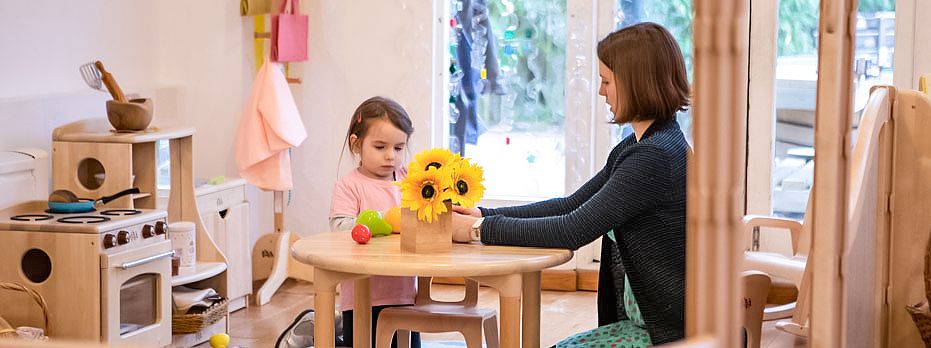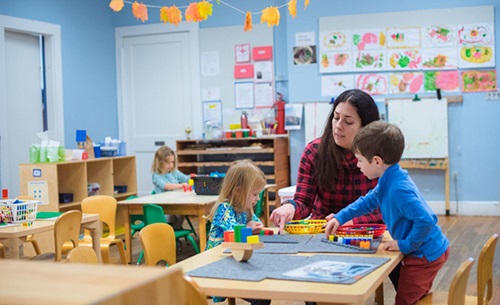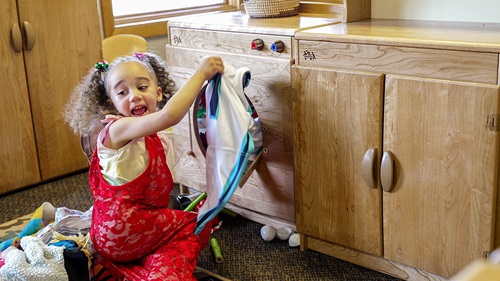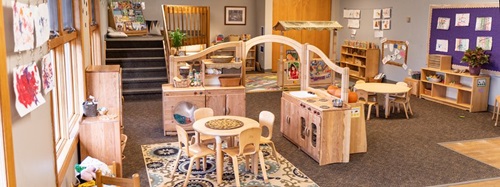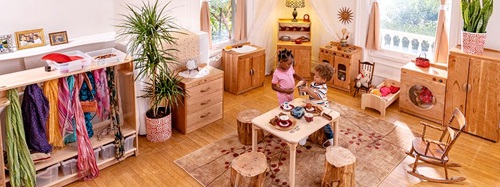Child Care in the 21st Century
| October 2007So what kind of place is a child care center or home to be? Twenty five years ago when I first considered the question, we were raising a generation of subterranean children. The answer to what kind of place in practice was clear: crowded, quite possibly underground, almost all square footage licensable child activity space, with little room for storage or active intelligence - conferences, meetings, planning - or conducting the business of child care. Some programs had the decor of a thrift shop-assembled home; others were closer to a first grade classroom, often awash in commercial displays; many were a little of both.
In those days we had little vision of the enormity of the child care experience. In the process of helping a center start up an infant program in 1973 and settling a tiny little baby girl into the center, I made an idle calculation that changed my entire outlook on child care. This wonderful baby I welcomed into the center as an infant would probably spend up to 12,000 hours in child care through age seven - more time than she will spend in all of elementary school and high school. Her childhood was to be spent here.
Moreover, of course, she did not crawl in alone. She had a family; and this place and the complicated relationships that ensued would have a huge impact on her family, certainly more than the impact of a nursery school or Head Start program in 500 or so hours. In practice, the child care program and family would be raising this child together, and would shortly be the site of much of the development of the sibling relationship as well.
Out of the Shadows
Where are we now as we ricochet into the twenty-first century? The age of subterranean childhoods, while not exactly over, is slowing receding. The explosive growth of child care for all income groups, improved licensing standards, NAEYC accreditation, and the American Disability Act (ADA) have levitated most children to the first floor and into better places than 13 years ago. And with ADA, the expectation of accessibility has opened up environments for many children left behind in the past.
The age of building for early childhood has brought with it exciting new possibilities and new design issues. Not having to make do, or fit into found space, and having windows, toilets right there, and water at hand(!) is wonderful. Having to squeeze down the square footage and make all sorts of compromises because of new and renovated building costs is not. The rise of a commercial market for educational equipment and materials has led to wonderful new resources for providing safer and possibly better-equipped environments but has created a new concern: sterile environments of plastic and polyurethaned wood - ersatz richness and a devaluation of the found and the real.
In the Public Eye
The growing awareness of the importance of early experience through widely publicized research on development, particularly on the brain, is very positive. But combined with America's genius at turning everything into a purchasable commodity, our can-do engineering approach, and the quintessentially American strong desire to get ahead, get an edge, be the best - the results of that consciousness are mixed. The same awareness that fuels the desire for more and better early childhood programs is behind the commercial efforts to convince parents that you have to have the "newest" or "best" to build a better baby or future adult. The best that money can buy: toys, software, child care center, school, camp, vacation, or enrichment programs. The best childhood, or life for that matter, is not simply a commodity to be bought. We all lose if experience that is not packaged or purchased is devalued, and if quality is assessed by its commercial value.
The modern kindergarten resembles the first grade of the 1980s, and there is considerable pressure that preschool programs drop the pre and perform the serious business of school readiness. The design of children's environments is, of course, hostage to this controversy. The child as student or the child as learner? Classroom? Laboratory? Studio? Homebase? Children's environments need to be designed to accomplish and to articulate the educational goals set forth by the program. This will result in variations designed to allow a variety of pedagogical experiences but should no doubt incorporate all of the above concepts, hopefully casting the child as a very active learner and messy little scientist.
The Influence of Reggio Emilia
The discovery and embracing of Reggio Emilia has reinvigorated the progressive approach to early childhood education, brought an extraordinary attention to the details of quality in all dimensions, particularly the environment, and done much to inspire countless early childhood professionals. Adopting Reggio's disciplined focus on "the image of the child" as competent human being; emergent curriculum and evaluation through documentation, dialogue, and analysis may help to offset the pressure to mimic elementary school. Reggio's focus on centers as aesthetic places has literally shed light on the concept of children's environments.
Twenty-first Century Child Care: What Kind of Place?
Ten qualities characterize the kind of place I would like to see my grandchildren experience. Obviously, each of the qualities has implications beyond environment: policies, practices, organization, and culture will also determine what kind of a place the program is.
1) A Great Place to Live: A non-institutional, welcoming place to be for the enormous amount of time that a child spends at the center.
Eating, drinking, sleeping, separating, and reuniting with loved ones, growing, changing, learning, falling in and out of love, getting knocked down and picking oneself up, deeply despairing and being filled with joy: living. Depending on us - living fully or not, living well or not. If we are to create places to live, the environment encourages competence, comfort, and acceptance of each individual: quirks, needs, and disposition. Home is where they have to take you.
2 )A Place of Beauty: A sensoryscape of taste and sensibility that encourages an appreciation of life and what the world has to offer.
What is beautiful? Beauty, of course, is in the eye of the beholder - and culture and upbringing certainly play a huge role. It is a matter of taste. If every program community aspires to create a place of beauty, the end results will be different and perhaps idiosyncratic, but I suspect it would reduce the psychedelic kaleidoscope of every wall and window covered with a riot of color and information (however valuable); the too lush rainforest of hanging materials from the ceiling; and the proliferation of cute, commercial images, permanent murals, and cheesy decor.
When the beholder is a child, who experiences the world through his senses more than the cognitively, beauty is more than visual. Beauty flows from the sensory experience. A children's environment is an aromascape, soundscape, colorscape, lightscape, and the world one can experience through the skin, the fingers, and the taste buds.
3) A Place that Promotes Strong Families: A place that supports the rights and responsibilities of parents and the development and well-being of families.
It is easy to believe in families - in respecting and supporting families. But practicing what we preach is much, much harder. Families come in all shapes and sizes, with cultures, beliefs and values that are not always quite aligned to our practice, "the way we do things here." One size does not fit all, and the way a family lives their life may well be here and there at odds with our efforts to maintain some sort of order and reason in our policies and practices.
A place for families means welcoming families into an understandable place and taking into account the presence of families in the size and scale of space. It means allowing for multi-age sibling interactions inside and out. A place that empowers families has the capacity for display and documentation that keeps families engaged and places for confidential discussions and meetings.
4) A Community of Caring: A place that encourages long term, warm, meaningful relationships between adults and children who know and trust each other.
Does the environment support relationships and community - or divide people up by the narrowest of age ranges and keep them apart, divided by classroom, age, and role? It is hard to calibrate the developmental damage when children are cared for by a succession of relative strangers, however kind and skilled - nice people who blink in and out of their life as they progress through the center. It must be similar to being an adult and experiencing the difference between a love life within a committed relationship and a series of one-night stands or short-term affairs. However exciting, the loss is enormous.
We know that young children spend an enormous amount of real energy coping with unfamiliarity and change, that exploration and learning is built on a foundation of security, and that emotional and moral intelligence grows from a foundation of early trust and guidance. Calibrated or not, whether made visible by children in distress or invisible because the lost potential is not tangible, the damage done by shallow relationships and the lack of community is real.
Community flows out of an organization and environment that values and sustains relationships. An environment can support connecting and gathering people together with gathering places and transparency that allows glimpses from place to place. It can also be designed for moments of feeling alone or with another to allow respite from the group, and to support relationships that last over time.
5) A Place for Learning Together: A warm, secure place that encourages ample responsive adult-child interactions, huge amounts of language and intellectual stimulation, great conversations, and many moments of undivided attention.
Perhaps the quickest and most fundamental evaluation of a child care setting is to observe the quantity and quality of conversation. To note whether adults are listening to children, provoking the ideas of children, and offering a child one of their most precious gifts - undivided attention and their full human presence. How can this occur with real world ratios and group sizes and all the daily demands of care? It can only happen in environments that support teachers and are well designed and prepared for independent use by children. And how would the environment change if designed for conversation? Perhaps with acoustics and places that lend themselves to conversation: couches, benches under a tree, a Snuggli® that puts the baby right there for all the murmurs and reassuring words.
6) A Safe, Nurturing, Creative Environment Designed for Exploration and Learning: A safe place of high expectations that engage andchallenge the mind and body of all ages of children; preparing them for success in school and life.
Is challenge possible for children who need to live exuberantly and explore with their bodies; who punctuate their discoveries with noise and movement? Yes, if given room to grow and the freedom to test their limits. Every program has to decide where they lie in protecting their child from possible harm - from life in a bubble to "you're on your own." The range of what constitutes a safe and healthy environment and what exploration and challenge is reasonable for young children is narrowing. Challenge and exploration and natural and wild are words that when applied raise as many concerns as create a sense of opportunity.
But if a child is not allowed to stumble and fall, how will she learn to pick herself up? If children in care are not allowed physical challenge and the inevitable normal bumps, bruises, and scratches of childhood, aren't we scotchguarding childhood and robbing the children of their luster? If the indoor and outdoor environment is not rich with the stuff of exploration and the air alive with what and why and how questions and expectations of disciplined research, our low expectations will surely diminish their vision of themselves and stunt their development.
7) A Place to Raise Competent, Responsible, and Compassionate Children: A place that encourages the development of responsibility, compassion, and community.
Institutional living - how does that sound? Institutions typically are not breeding grounds for competence, independence, responsibility, compassion, and community. To be that a place needs to be designed for the inhabitants to be together, work together, depend on each other, become competent and take responsibility for daily life and growth. An environment designed for competent staff and children can expect the inhabitants to work together and contribute to daily life, to setting up and taking down and to preparation and cleaning up.
8) A Great Place to Work: A place that supports active intelligence, competence, growth, collegiality, and the demanding emotional requirements of a complex and difficult job addressing the needs of children, families, community, and staff.
What do you have if you fail to provide office space, resource rooms, a staff lounge or workroom, ample storage, places to meet or have confidential meetings, and the means to support adult communication? A place that assumes adult mindlessness, a simple place for a simple task and simple people - routine, no collegiality, no creativity, no intellectual life or history. Only the heroic efforts of talented and committed people overcome the preordained mediocrity, workplace despair, and burnout likely to follow when we cheat on the required spaces for active intelligence.
9) A Place In and Of the Wider World: A place connected to the natural world, the larger community, and the world beyond.
The twenty-four hour world of sensational news and increasing alienation from the natural world has created the sensibility that our world is a terribly perilous place for an American child - potential harm lurks with every stranger and every strange thing. The idea of an accident is being replaced by the notion that there has to be liability somewhere, if not downright malevolence.
But children raised in well-meaning bubbles, disconnected from the world outside the windows of the center or the car or the fence, are effectively crippled and will be more vulnerable as they grow up. And childhood is when human beings are supposed to fall in love with the world and its complicated delights and mysteries. Do we really want children to know more about migrating humpback whales on the Discovery Channel than the sparrow, the worm, and the willow outside? Or develop their concept of city life from sensational police dramas rather than walks? Most four year olds easily distinguish between the Golden Arches and the Taco Bell, but not the sparrow and the chickadee or the elm and the maple.
Beyond exploring the backyard and cityscape, twenty-first century technology can connect adults and children to others anywhere and put a whole world of resources at their command. A twenty-first century children's program can be wired and global, connected to the information age, ready to serve children and families of diverse origin, and ready to begin children on the path to global citizenry.
10) A Place for Childhood: A great place to be a child for the one childhood he or she will have.
When everything comes together; when we get it right and it truly is a wonderful place to be a child for those 12,000 hours, and a great place to be with a child for a career - a place in and of the world - we have created a place for a childhood.
Used with permission from Exchange Magazine, www.childcareexchange.com

